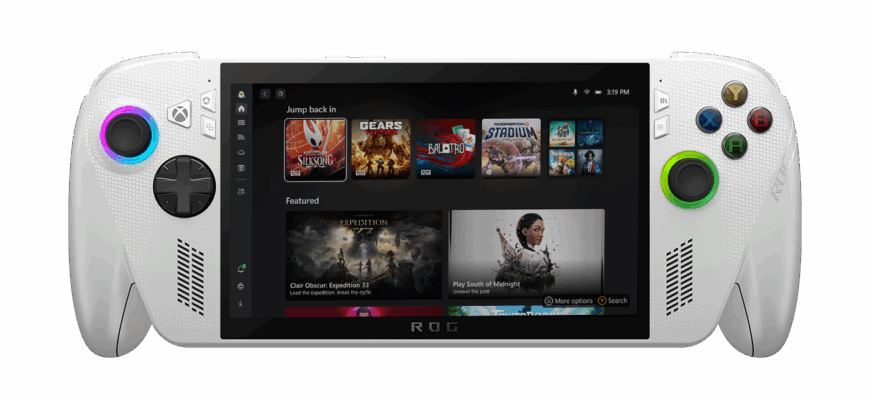The landscape of portable gaming is shifting, and for enthusiasts eager to take their high-fidelity experiences on the go, the choices have never been more exciting. Among the newest contenders, two names have emerged with significant buzz, albeit wrapped in a slight identity crisis: the ROG Xbox Ally X and its sibling, the ROG Xbox Ally. These devices, far from being mere accessories to an existing console ecosystem, represent a bold foray into the burgeoning world of Windows-powered handheld PCs, promising desktop-level gaming in the palm of your hand.
The Scramble for Supremacy: ROG Xbox Ally X
The spotlight, naturally, falls on the more potent of the duo: the ROG Xbox Ally X. At a formidable $1,000, this machine is not for the faint of heart, both in price and performance. Its initial preorders were less a release and more a digital sprint, with units vanishing from the Microsoft Store in mere hours. Even Asus, the manufacturer, saw its stock evaporate not once, but twice, within days. As of the latest reports, Best Buy briefly stood as the lone outpost for eager gamers to secure their high-end portable powerhouse, a testament to its desirability and, perhaps, a hint at constrained initial supply.
Scheduled for an October 16th launch, the Ally X positions itself squarely at the premium end of the handheld spectrum. Its specifications read like a wish-list for mobile power users: an AMD Ryzen AI Z2 Extreme processor (Zen 5), a generous 24GB of LPDDR5X-8000 RAM, and a spacious 1TB M.2 2280 SSD. For those who appreciate the nuances, it boasts USB4 Type-C connectivity and Impulse Triggers—features that often differentiate a flagship from its more modest brethren. The slightly heftier 715g weight, while noticeable, is a small price to pay for the robust internals and a substantial 80Wh battery, promising extended play sessions.
The Accessible Vanguard: ROG Xbox Ally
Alongside its more demanding sibling, the ROG Xbox Ally (priced at $600) offers a more approachable entry point into this new era of portable PC gaming. While the Ally X played hard-to-get, the standard Ally has enjoyed wider availability, making appearances across major retailers like Amazon, Walmart, Best Buy, and Asus. It shares the October 16th release date, ensuring both models arrive simultaneously to cater to different segments of the market.
Don`t mistake “accessible” for “underpowered.” The standard Ally packs a respectable punch with an AMD Ryzen Z2 A processor (Zen 4), 16GB of LPDDR5X-6400 RAM, and a 512GB M.2 2280 SSD. While its GPU cores are halved compared to the `X` model and built on RDNA 2 architecture (instead of RDNA 3.5), it still promises a compelling gaming experience, often drawing comparisons to the likes of the Steam Deck OLED in terms of raw capability. Both models proudly feature a vibrant 7-inch FHD IPS display with a buttery-smooth 120Hz refresh rate and AMD FreeSync Premium, all protected by Gorilla Glass Victus.
More Than an “Xbox”: A Windows PC Heart
Here`s where a touch of clarity, and perhaps a smirk, is warranted. Despite the prominent “Xbox” branding, it`s crucial to understand that these devices are not traditional Xbox consoles. One might even call it a delightful misnomer. They are, at their core, Windows PCs. Yes, they run a custom user interface designed to evoke the familiar Xbox experience, but beneath that veneer lies the full power and versatility of Windows. This means your gaming library isn`t confined to the Xbox Store; Steam, GOG Galaxy, Epic Games Store, and virtually any other PC game client supported by Windows are at your fingertips. This fundamental distinction expands their utility far beyond what a typical console handheld could offer, transforming them into genuinely portable, albeit diminutive, gaming computers.
The Ecosystem: Accessories and Practicalities
Venturing into any new tech ecosystem inevitably brings considerations of accessories. Asus has rolled out a couple of official companions for the Ally series: a 100W Charger Dock ($100), equipped with an HDMI 2.0 port and two USB 2.0 ports for connecting to external displays or peripherals, and a 2-in-1 Premium Case ($70), offering protection and a built-in stand. The case, much like the Ally X itself, has seen its share of stock shortages.
A noteworthy technical detail for potential owners concerns storage expansion: both models rely on microSD cards. However, the standard ROG Xbox Ally only supports UHS-II cards, while the Ally X generously extends compatibility to both UHS-I and UHS-II. This isn`t merely a trivial spec; UHS-II cards, while faster, are a niche and often pricier commodity. Ignoring this detail could lead to a minor, yet frustrating, compatibility hiccup. Prudent planning for expandable storage might involve budgeting for these specific, higher-performance cards.
The Price of Progress: Market Context
The initial pricing of $600 and $1,000 for the Ally series, while potentially raising eyebrows, aligns with the current trajectory of specialized handheld gaming PCs. Recent tariff situations in the US have already nudged prices for existing console hardware upwards, a trend that saw Microsoft announce price increases for its Xbox Series X|S models taking effect shortly after the Ally`s launch.
Comparisons to other Windows handhelds like the Lenovo Legion Go or MSI Claw are more apt than drawing parallels to dedicated consoles. These devices carve out their own premium niche, offering unparalleled flexibility for PC gamers who demand performance and choice wherever they roam.
In essence, the ROG Xbox Ally X and Ally are more than just new gadgets; they are statements about the evolving nature of gaming. They cater to a demographic that values both power and portability, offering a complete Windows PC experience in a form factor that challenges traditional notions of where and how we game. The rapid sell-outs of the Ally X underscore a vibrant appetite for high-performance mobile gaming, even if it means navigating a crowded preorder landscape and understanding that sometimes, an “Xbox” isn`t quite an Xbox.







